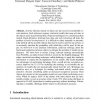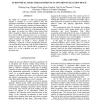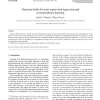101 search results - page 14 / 21 » Activity Recognition Based on Semi-supervised Learning |
PERVASIVE
2006
Springer
13 years 7 months ago
2006
Springer
Abstract. Activity inference based on object use has received considerable recent attention. Such inference requires statistical models that map activities to the objects used in p...
ICMCS
2005
IEEE
14 years 1 months ago
2005
IEEE
The ability of a computer to detect and appropriately respond to changes in a user’s affective state has significant implications to Human-Computer Interaction (HCI). To more ac...
ECCV
2008
Springer
14 years 9 months ago
2008
Springer
Abstract. The use of sparse invariant features to recognise classes of actions or objects has become common in the literature. However, features are often "engineered" to...
PR
2006
13 years 7 months ago
2006
Gaussian fields (GF) have recently received considerable attention for dimension reduction and semi-supervised classification. In this paper we show how the GF framework can be us...
ICASSP
2011
IEEE
12 years 11 months ago
2011
IEEE
In this paper, we describe a novel speaker adaptation algorithm based on Gaussian mixture weight adaptation. A small number of latent speaker vectors are estimated with non-negati...



